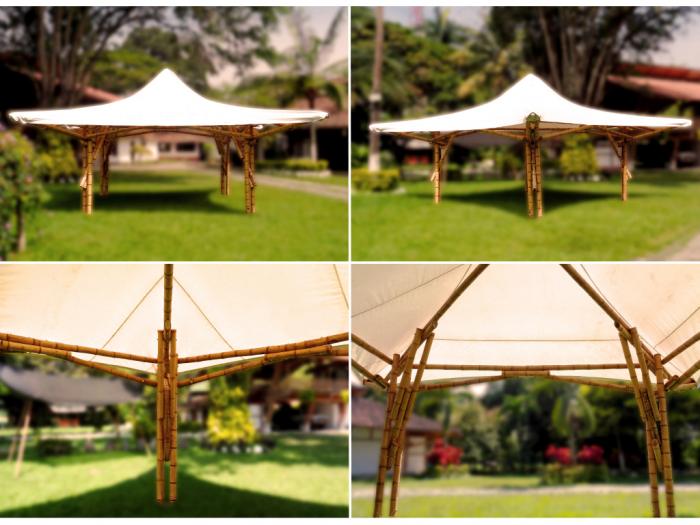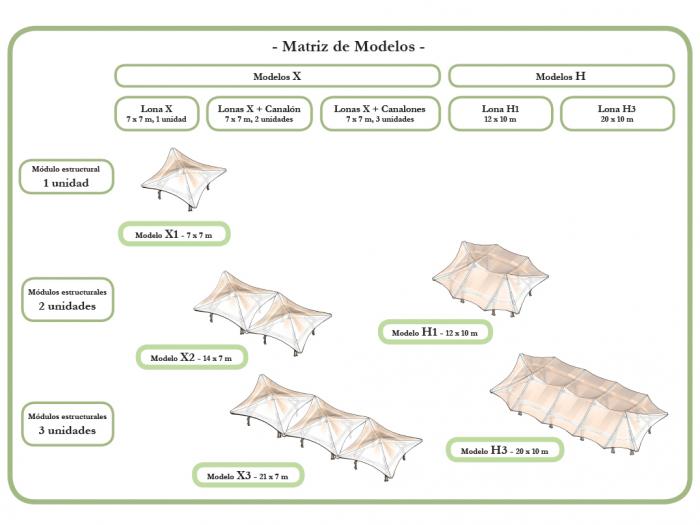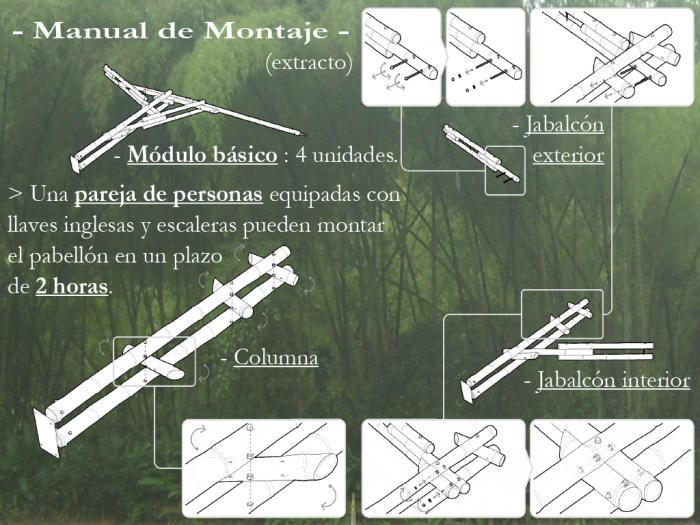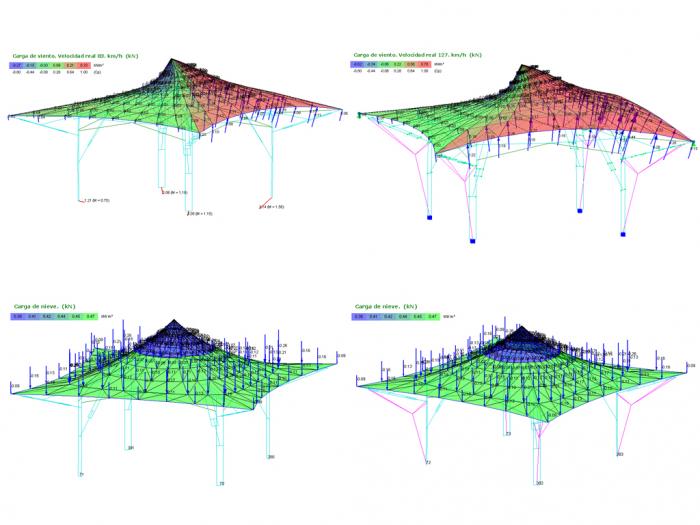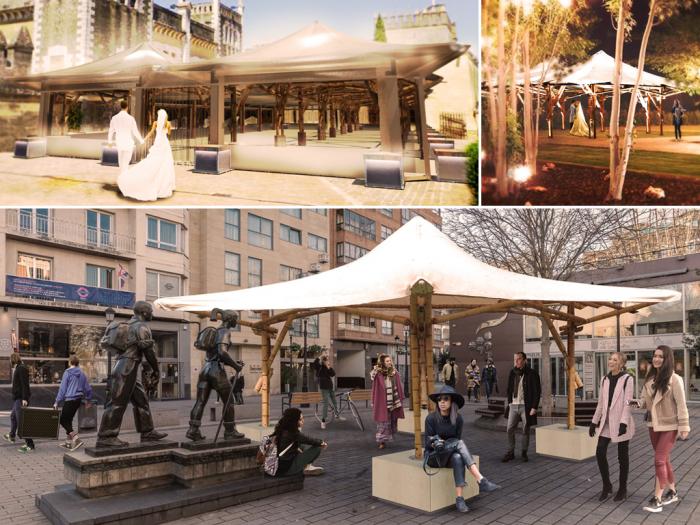I. SUMMARY INFORMATION
Project
269691
Status
Submitted
Award category
Techniques, materials and processes for construction and design
You want to submit
NEW EUROPEAN BAUHAUS AWARDS : existing completed examples
Project title
Bamboopod®: tensile & bamboo structures.
Full project title
Lightweight modular structural system based on bamboo as support and tensile fabric as covering.
Description
Bamboopod® is the first and only system combining the natural beauty of bamboo with the cutting-edge technology of tensile architecture, fully prefabricated and buildable easily by a pair. Suitable both for temporary installations and for permanent uses, it is calculated to stand snow loads and wind speeds over 120 km/h. It provides the unique experience of being instantly transported to a peaceful state of mind, bringing the feeling of impressive order due to the natural beauty of bamboo.
Where was your project implemented in the EU?
Spain
Madrid
Instituto de Ciencias de la Construcción Eduardo Torroja, calle Serrano Galvache, 4
-
-
Madrid
28033
When was your project implemented?
Has your project benefited from EU programmes or funds?
No
Which programme(s) or fund(s)? Provide the name of the programme(s)/fund(s), the strand/action line as relevant and the year.
II. DESCRIPTION OF THE PROJECT
Please provide a summary of your project
Bamboopod® is the first and only system combining the natural elegance and beauty of bamboo and the cutting-edge, high-technology of tensile architecture, which is among the most innovative fields in architectural and structural design. To make possible this combination and to overcome the logistical challenges of transportation and storage, it was essential to review bamboo construction techniques, both traditional and recent.
To build with negative, or at least neutral, carbon footprint is the objective of this Bamboopod®, as it should be for the construction industry. Building with bamboo makes this possible.
Bamboopod® aims to provide the unique experience of being instantly transported to a peaceful state of mind, bringing the feeling of unexpected, impressive order due to the natural beauty of bamboo.
The ambition of Bamboopod® in terms of inclusion is to create job opportunities where the resource is available, also where the prefabricated structures are produced, as well as where they are installed. Building with bamboo expands the opportunities for a green economy.
Besides fighting climate change and creating jobs, Bamboopod® provides freedom in terms of design and configuration, since the options are numerous with the use of just a few structural members; of course, the more units of basic modules available, the more options of configuration are possible.
Witnessing Bamboopod® is enough to raise awareness of alternative building techniques, while meeting building codes and regulations, as long as applied properly. Moreover, it enhances the cultural identity of population from where bamboo for construction is endemic and makes people proud of promoting their natural resources.
The covering is customized by every client. When Bamboopod® is lit up with indirect lights pointing up to the tensile fabric from the inside, the covering turns into a huge lampshade, boosting the enchanting character of these exotic, almost mystical, pavilions.
Please give information about the key objectives of your project in terms of sustainability and how these have been met
To build with negative, or at least neutral, carbon footprint is the objective of this Bamboopod®, as it should be for the construction industry. Building with bamboo makes this possible.
A 6-meter-long and 8-10 cm diameter stem of bamboo Guadua angustifolia captures an equivalent carbon content of 22 kg. Treating the raw material and shipping it from Colombia to Spain, assuming these processes are optimized, represents 4 kg of carbon equivalent content. Therefore bamboo, even when it is shipped in its natural shape (round, hollowed poles) from the other side of the world to Europe, still has a good chance to be not only ‘carbon neutral’, but even ‘carbon negative material’ due to a negative yield of 3 kg of carbon equivalent per meter, so a carbon sink until the material is decomposed or burnt. Even at the end of its life cycle, when the carbon once sank is released back to the atmosphere, bamboo has comparative advantages to other building materials: it does not leave any waste, since it is biodegradable; moreover, in case it is burnt properly to be used as fuel, it avoids the use of other sources of energy that are not renewable or have more impact on the environment due to extraction and processing costs.
On the other hand, the material used as tensile covering is made out of high-performance PET (polyester) fabric coated in PVC (polyvinyl chloride). None of these 2 artificial polymers is renewable nor biodegradable since they are outcomes of the petrochemical industry. However, the Texyloop® method patented by Serge Ferrari® Group makes this material fully recyclable to be reused in other applications and therefore not producing wastes.
To build a 7x7 m basic module of Bamboopod®, 25 m of bamboo are used. After treatment and shipping, 3 kg of captured equivalent carbon per meter is the balance. Then, regarding bamboo, a 7x7 m module installed in Spain has a negative carbon footprint of 75 kg to compensate the production of new fabrics.
Please give information about the key objectives of your project in terms of aesthetics and quality of experience beyond functionality and how these have been met
Bamboopod® aims to provide the unique experience of being instantly transported to a peaceful state of mind, bringing the feeling of unexpected, impressive order due to the natural beauty of bamboo
The harmony of the composition is based on the reiterative use of the Golden Ratio. Firstly, when a basic Bamboopod® is observed from the distance, its front view inscribes itself within a golden ratio rectangle. Yet at the elevation level, between the ledge, the ground plane and two columns, another golden ratio rectangle is observed. Last, perhaps harder to be perceived from users’ perspective but certainly contributing to the harmonic feeling of the whole, the length of the sides of the square formed by the columns and the length of the sides of the square formed by the covering, are as well related through the Golden Ratio.
The shape of the covering fabric, composed by four intersected hyperbolic paraboloids, creates a graceful pyramid where the edges are gentle parables and where faces are indeed the mentioned double-curvature surfaces. From above, the covering fabric seems an odd 4-pointed sea star while the fifth point is looking up, perpendicular to the plane where the other ones are located.
The feeling of bamboo sprouting up from the ground level and coming together above users’ heads to form a cohesive, sound structure, brings a cosy feeling when experiencing Bamboopod® from within.
The covering is customized by every client: it can be translucent or opaque, and it is available in different colours. Moreover, logos or typing could be added. Lit up with indirect lights pointing up to the tensile fabric from the inside, the covering turns into a huge lampshade, boosting the enchanting character of these exotic, almost mystical, pavilions.
Please give information about the key objectives of your project in terms of inclusion and how these have been met
The ambition of Bamboopod® in terms of inclusion is to create job opportunities where the resource is available, also where the prefabricated structures are produced, as well as where they are installed. Building with bamboo expands the opportunities for a green economy.
When used for construction, especially in its natural round shape, bamboo is selected before harvest and carefully handled afterwards. Other uses, such as paper and cardboard making, do not require this kind of dedication; in fact, for most of the purposes other than construction with round pole bamboo, it is harvested ‘in bulk’ using machinery; i.e., tractors with chainsaws). For construction, despite the running cost of a plantation being very low, harvest must be done culm by culm, therefore labour intensive, using no heavy machinery, just basic tools, i.e., machete or chain saw. This is the reason why bringing bamboo into the mainstream as a building material is more likely to provide more and better jobs than dealing with mineral-based materials, such as cement or steel.
The value chain related to bamboo as building material will widen the spectrum of beneficiaries, at the same time relieving the environment from the impact of other industrial practices related to construction. This leads to secure jobs and create new ones, especially in places where opportunities are lacking.
Depending on the specifications of a project and its site conditions, average price of Bamboopod® per square meter is around 250 € (including bamboo structure and tensile covering), making it competent and affordable in the European market despite its exclusive appealing, high end, environmental advantages and amazing structural performance. In addition to the, the final users, being able to instal Bamboopod® by themselves, increase their sense of belonging.
Please give information on the results/impacts achieved by your project in relation to the category you apply for
Bamboopod® showcases and promotes the use of bamboo as the ultimate weapon to fight climate change. Bamboopod® is a solution for both temporary and permanent uses. Temporary, because it only takes about 2 hours to assemble or dismantle (by 2 workers equipped with wrenches and ladders) with no need of scaffolding or crane, therefore it can be built on sites where machinery or heavy load traffic have no accessibility. It is also suitable for permanent uses due to its outstanding structural performance.
The other key component of Bamboopod®, the tensile cover (made out of polyester fabric with PVC protection), is fully recyclable through the Texyloop® process. As a result of this, the tensile cover does not generate any waste.
Prefabrication applied to bamboo, as to any other material, allows to control the material and workflow in the production facilities. For this reason, safe working conditions are guaranteed, and cutting down waste generation to the minimum, which it is mostly biodegradable.
Whereas most current building practices and product developments have a deep environmental impact which might be minimized only relatively and compensated through side-actions, building with bamboo leads to carbon neutral or even carbon negative building practices. This is a real turning point in the development of the building industry, shifting from a model based on the extraction of non-renewable resources and the pollution of the environment, towards a model based on using extremely renewable resources and capturing carbon from the atmosphere in the meantime. Building with concrete or steel releases carbon, while building with bamboo potentially turns every building into a carbon sink.
Please explain the way citizens benefiting from or affected by the project and civil society have been involved in the project and what has been the impact of this involvement on the project
Bamboopod® contributes to the fight against global warming and climate change. Building with bamboo, specially when it is treated properly and used in its round natural form, sequestrates carbon, avoiding desertification and enhancing biodiversity. These are important benefits for their makers and their users. Another asset of Bamboopod® is the job creation it brings, at least at three levels directly: 1. Cultivation and harvest, 2. Treatment and production, 3. Distribution and installation. Indirect job creation affects logistics (transportation and storage) and packaging among other sectors.
Besides fighting climate change and creating jobs, Bamboopod® provides freedom in terms of design and configuration, since the options are numerous with the implication of just a few structural members; of course, the more units of basic modules available, the more options of configuration are possible. Together with the characteristic of being built and dismantled easily, and then built again perhaps using a different layout, the involvement of users in laying out spaces with a clear set of design lines is another benefit for civil society involved in the project, either as private or as public agents.
Witnessing Bamboopod® is enough to raise awareness of alternative building techniques while enhancing the cultural identity of population where bamboo for construction is endemic. Its uniqueness contributes to the create or reinforce the identity of the places where it is installed.
The elements composing the basic modules of Bamboopod® give already freedom of design to the final user, particularly regarding set up of the whole and layout of the covering. However, the possibilities become limitless when dealing with customized designs addressed and driven by specific users, always based on the principles of the patented system.
Please highlight the innovative character of the project
Bamboopod® is the first and only system combining the natural elegance and beauty of bamboo and the cutting-edge, high-technology of tensile architecture, which is among the most innovative fields in architectural and structural design. To make possible this combination and to overcome the logistical challenges of transportation and storage, it was essential to review bamboo construction techniques, both traditional and recent.
The concept of prefabrication applied to bamboo makes it possible to build with structural round pole bamboo anywhere in the world, even in those places where there is no tradition or practical knowledge on how to use this material in construction. This also allows the system to be built and dismantled as many times as desired, while benefiting from low-cost shipping to any destination. All the pieces in the system are arranged in boxes of less than 50 kg each, so two workers can carry the boxes one by one. A basic module (covering 7 by 7 m), when dismantled, is package in a total of 7 boxes, 3 m (either horizontally or vertically), by 1 m, by 1 m, and weights a total of 250 kg.
The system is currently patented with a utility model in Spain and it has a patentability report with positive result, therefore meeting the required criteria of novelty, inventiveness and industrial applicability. It is worth mentioning that the patented system, despite having been conceived to expand the use of round pole bamboo as structural building material, it could be applied to other materials (i.e., cardboard tubes, aluminium or PVC pipes, roundwood, etc.) and structural design, providing it is fully triangulated to assure three-dimensional stability. Although all the current commercial models are one-level, the patented system in which these models are based allows also for the design of different structural elements in order to achieve multi-storey or larger free-span structures.
Please explain how the project led to results or learnings which could be transferred to other interested parties
The pilot project was implemented from scratch in a production facility. From prototyping to serial production required one month. Unitary production time for the basic modules was reduced to half in one month of fine-tune production line. Despite the limited investment, this successful timeframe reflects the high degree of transferability of Bamboopod®.
Its production does not need heavy equipment, just a few portable power tools and a workbench. Thus, the economic investment required to implement a Bamboopod® production line is inexpensive. As proven during the implementation of the pilot project, workers only need a minimum training in the use of tools and basic knowledge of carpentry, quickly understand and learn the production process. Regarding the tensile covering, its design and manufacturing in available nowadays in any continental region by experienced companies in the field. Depending on the balance of production and logistics costs, the covering could be produced in the same place where the bamboo structures are produced or in the destinations of the structures.
Where the installation takes place, another pair of workers (even with no previous training) will be able to construct Bamboopod® within approximately 2 hours, just equipped with wrenches and ladders. The manual provides all the information required in order to build up and to dismantle the Bamboopod® modular units, and presents it in an easy-to-understand, graphic-based fashion.
Is an evaluation report or any relevant independent evaluation source available?
III. UPLOAD PICTURES
IV. VALIDATION
By ticking this box, you declare that all the information provided in this form is factually correct, that the proposed project has not been proposed for the Awards more than once under the same category and that it has not been subject to any type of investigation, which could lead to a financial correction because of irregularities or fraud.
Yes

